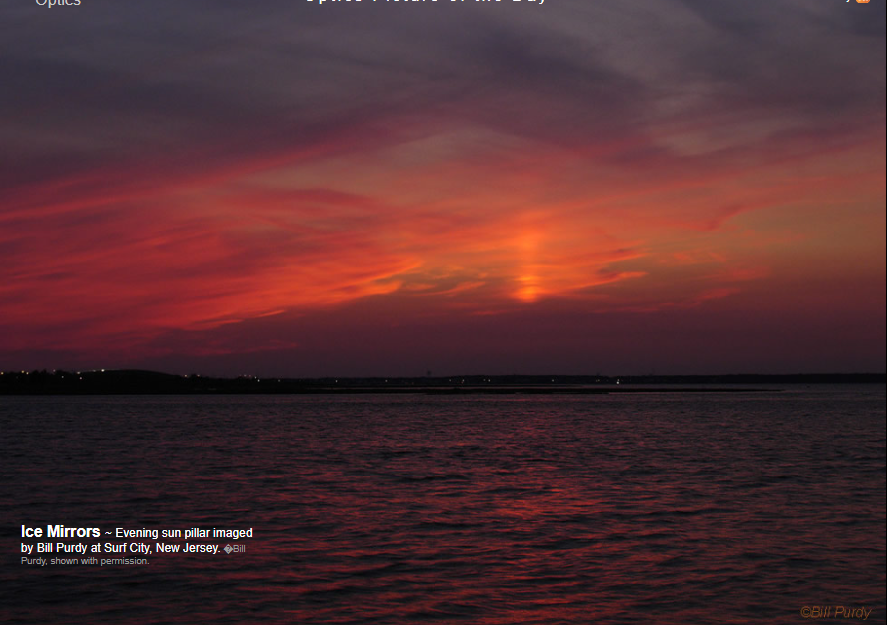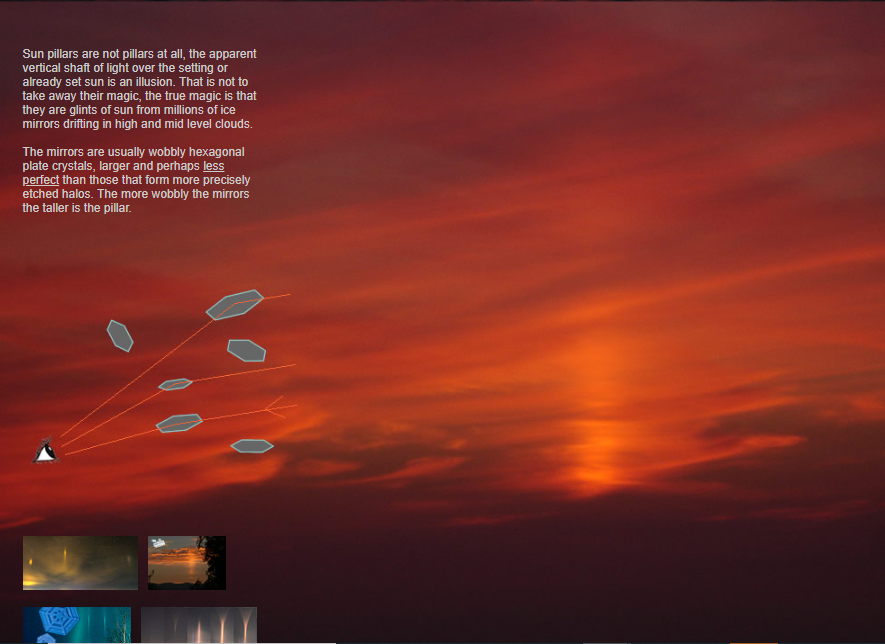Ice Mirrors
Ice Mirrors: Unveiling the Magic of Sun Pillars
When gazing at the evening sky, you may have been captivated by the ethereal beauty of a sun pillar, an apparent vertical shaft of light extending above the setting or already set sun. However, this enchanting spectacle is not actually a physical pillar but rather an optical illusion. But fear not, for the true magic lies in the millions of ice mirrors suspended within high and mid-level clouds that create these mesmerizing phenomena.
These ice mirrors, also known as wobbly hexagonal plate crystals, play a crucial role in the formation of sun pillars. While they may be larger and less perfect compared to the intricately etched halos they produce, their imperfections contribute to the height and magnificence of these illusory pillars. The wobblier the mirrors, the taller the pillar appears to be.
To delve deeper into the world of ice mirrors and sun pillars, let's explore some fascinating details:
The Science Behind Sun Pillars
Sun pillars are a result of the interaction between sunlight and ice crystals suspended in the Earth's atmosphere. When the sun is low on the horizon during sunrise or sunset, its rays pass through a layer of clouds containing these tiny ice crystals. The crystals act as miniature mirrors, reflecting and refracting sunlight in various directions.
Hexagonal Plate Crystals: The Building Blocks
The primary players in the formation of ice mirrors and sun pillars are hexagonal plate crystals. These flat, six-sided ice crystals are responsible for creating the glints of light that give rise to the illusion of vertical pillars. As sunlight passes through these crystals, it undergoes both reflection and refraction processes, leading to the remarkable phenomenon we observe.
Wobbly Mirrors: Adding Height and Drama
While perfectly shaped ice crystals can create beautiful atmospheric halos, it is the imperfections in wobbly hexagonal plate crystals that lend sun pillars their majestic height and drama. These crystals are not uniform in size or shape, resulting in a scattering of sunlight in multiple directions. This scattering effect causes the light to appear vertically elongated, creating the illusion of a pillar stretching towards the heavens.
The Influence of Weather Conditions
The presence and intensity of sun pillars are influenced by specific weather conditions. For instance, the abundance of high and mid-level clouds containing ice crystals is essential for their formation. Additionally, colder temperatures tend to produce larger and more irregular ice crystals, enhancing the likelihood of observing these breathtaking optical illusions.
Variations in Sun Pillar Appearance
While sun pillars typically appear as vertical shafts of light extending above the sun, they can manifest in various forms depending on atmospheric conditions. Sometimes, the pillars may appear tilted or curved due to the wind's influence on the orientation of the ice crystals. In rare cases, multiple pillars can be observed, creating a mesmerizing display of light in the sky.
Capturing the Magic
Photographing sun pillars can be a rewarding endeavor for enthusiasts and photographers alike. By adjusting exposure settings and utilizing a telephoto lens, one can capture the intricate details and vibrant colors that accompany these awe-inspiring phenomena. The interplay between light, ice crystals, and atmospheric conditions provides endless opportunities for creative exploration.
Unveiling Nature's Optical Illusions
Sun pillars are just one example of the many extraordinary atmospheric optics phenomena that grace our skies. From halos and rainbows to iridescent clouds and mirages, nature constantly surprises us with its ability to create captivating illusions. By understanding the science behind these phenomena, we can appreciate the intricate beauty of our atmosphere and its role in shaping our visual experiences.
In conclusion, ice mirrors and sun pillars unveil a world of optical wonder hidden within our atmosphere. These illusory vertical shafts of light are brought to life by millions of wobbly hexagonal plate crystals, scattering sunlight and captivating our senses. The next time you witness a sun pillar stretching towards the heavens, take a moment to marvel at the magic created by nature's ice mirrors.

Ice Mirrors ~ Evening sun pillar imaged by Bill Purdy at Surf City, New Jersey. �Bill Purdy, shown with permission.

Sun pillars are not pillars at all, the apparent vertical shaft of light over the setting or already set sun is an illusion. That is not to take away their magic, the true magic is that they are glints of sun from millions of ice mirrors drifting in high and mid level clouds.
The mirrors are usually wobbly hexagonal plate crystals, larger and perhaps less perfect than those that form more precisely etched halos. The more wobbly the mirrors the taller is the pillar.
Note: this article has been automatically converted from the old site and may not appear as intended. You can find the original article here.
Reference Atmospheric Optics
If you use any of the definitions, information, or data presented on Atmospheric Optics, please copy the link or reference below to properly credit us as the reference source. Thank you!
-
<a href="https://atoptics.co.uk/blog/ice-mirrors/">Ice Mirrors</a>
-
"Ice Mirrors". Atmospheric Optics. Accessed on November 26, 2024. https://atoptics.co.uk/blog/ice-mirrors/.
-
"Ice Mirrors". Atmospheric Optics, https://atoptics.co.uk/blog/ice-mirrors/. Accessed 26 November, 2024
-
Ice Mirrors. Atmospheric Optics. Retrieved from https://atoptics.co.uk/blog/ice-mirrors/.